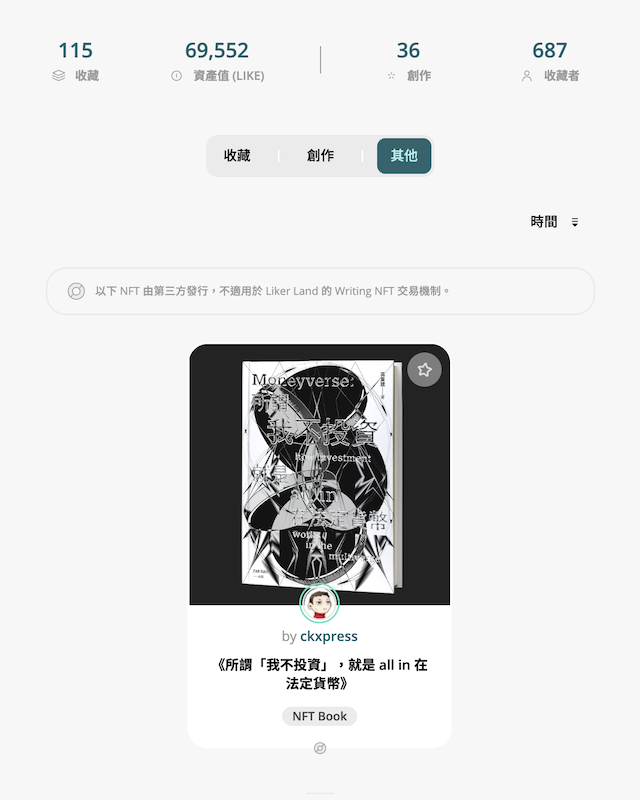Thanks to everyone’s support, the decentralized publishing experiment of Moneyverse: How money works in the multiverse has been successfully completed, with a total of 1,024 copies sold. In the past few days, I have been acting as a “human AI” to distribute NFTs, autograph and leave personal messages with “human-powered ChatGPT”. I have just finished distributing to all readers who have provided their wallet addresses, totaling 623 copies.
The computing power of human AI is very limited. At best, I can only autograph 25 copies per hour, and the whole process took longer than I expected. For an author, at least for me, getting to know each reader one by one is a joyful experience. However, due to my desire to get the books to everyone as soon as possible and working in large batches, it inevitably felt a bit like the protagonist in the movie A Clockwork Orange being forced to watch his favorite explicit violent films over and over again, becoming overwhelmed by the beauty in front of him.
The peak period has passed, and I will slow down and enjoy the pleasure of signing the remaining 639 copies. Now, let me address some of the questions readers encountered during the book purchasing process, hoping to provide clarification for everyone.
Where can I find my NFT book?
- Open the Liker Land website.
- Connect your wallet. In addition to Keplr which is the default, you can also use Cosmostation or scan the QR code with the Liker Land app to connect.
- Click on your avatar in the top right corner and select “My Bookshelf.”
- The “Collected” tab lists your collection, where you can find your purchased NFT books.
- Select Moneyverse to “Open” your NFT book.

How to understand the various information of the book?
- Dynamic Cover: each book has a unique cover. In addition to the regular silver coins, there are 99 covers with rare gold coins, and finally, there are 9 ultra-rare rose gold coins, like the one reader ninjag got. Their positions, rotation angles, and speeds also vary.
- Serial Number: The book’s “birth certificate” ranges from #0000 to #1262, totaling 1,263 copies.
- Ownership: The “Owned: 2” in the top left corner indicates that ninjag owns 2 copies of “I Don’t Invest”; the “Owned: 640” in the top right corner indicates that the user connected to the wallet, which is me, owns 640 copies. One of them is a love letter to myself, meaning I have 639 copies yet to distribute to readers.
- Messages: In addition to autograph, I also leave personal messages for different readers, and all of these messages are written on the blockchain. If the owner of the book passes it on, this section will also show the entire path and messages of the drifting book, making each book unique with its own life.
- View content: this refers to the content of the book. Click to download the PDF file of the book, and it will always be the latest version.

Did you allocate all the rose gold coin covers to close friends?
No, I didn’t. For example, I don’t know the aforementioned ninjag, at least to my knowledge.
I arranged all the readers in chronological order from #0000 to #1262:
- 26 readers who purchased my old works in 2018
- 117 readers who supported my writing through Civic Liker 2.0 in 2020-21
- 43 readers who subscribed to the “Sociology of Blockchain” weekly newsletter in 2021-22 after the closure of “Apple Daily”
- 53 readers who collected 3 related Writing NFT articles when the decentralized publishing experiment began
- 1,024 readers who purchased during the experiment
The computer then randomly allocated different covers to the 1,263 books (this time it’s not by “human AI”). In other words, the order in which wallet addresses are provided does not affect the covers obtained — but I still hope everyone will provide their addresses as soon as possible.
It is worth noting that for the first three groups of readers mentioned above, they didn’t know they would receive an NFT book as a reward when they paid. Even I didn’t know at the time, although the question how to reward these unconditionally supportive readers has always been in my heart.

Can I only read the book on this online bookshelf?
No, just as you would normally take a book off the shelf and read it on the sofa, at a cafe, on the subway, or at the beach, the online bookshelf can help you organize and display your collection, but after downloading the content, you can read it in various ways.
If you choose a formatted PDF file, the layout is fixed, and you can open it on any computer or tablet. As for the reflowable EPUB file, you can send it to any preferred e-reader, such as Kindle, mooInk, Kobo, and Boox. If you are using an iPad or a computer, it is recommended to use Google Play Books for a great reading experience.
I still prefer reading physical books, is that not possible?
While I hope everyone will be environmentally conscious, it is entirely possible to print the book. You have the right to duplicate it in any form without being held accountable for piracy.
There is a detail that almost no one knows: the layout of the book’s PDF file is intentionally made in A5 size. You can reuse A4 paper used for protest purposes, and double-sided printing can print 4 pages of the book; 53 sheets of A4 paper are enough to print the entire book.
In fact, this innovative approach has already been done by a reader, who even brought it to the book launch event at the Taipei enclave bookstore for me to sign. It took me by surprise and almost moved me to tears.

Isn’t this just like the old Anobii or Douban? What’s special about it?
You’re right, this is the web3 paradigm of the online bookshelf.
Compared to web2, the biggest improvement of web3 is the implementation of “ownership”. In the context of bookshelves, you used to be able to add any book to your personal bookshelf, but the Liker Land “web3 bookshelf” only displays books and articles you have actually purchased. Moreover, when you sell or give out a book, it will disappear from your bookshelf.
In addition, with web3 applications, the front-end interface and the back-end data are separated. Even if the company developing the front-end application is no longer around, the social group among authors and readers, readers’ reading history, and content of the books will not disappear along with it.
Another situation is that since the data is openly stored on the blockchain, anyone with technical ability can develop more bookshelf websites and apps to present the information, leading to healthy competition and a wealth of choices for users. Imagine moving from Facebook to MeWe and being able to take all your posts and relationship maps with you, and you can understand the power of separating applications and data.
I’ve clearly purchased it but haven’t received the NFT, did you run away?
Don’t trust, verify. It is the best practise not to blindly trust me, but I honestly have no plans to run away.
On the contrary, I am eagerly looking forward to the remaining 639 readers providing their wallet addresses so I can sign and send the books to them. The current situation is like they have purchased physical books but haven’t provided a mailing address yet. Besides being busy and not having time, I believe many people have not noticed the email. Readers who haven’t received the book, please check your mailbox for an email from [email protected], and also check if it has been mistakenly classified as spam. If not, I will continue to follow up by resending emails, striving to sign and send out all the books, not missing a single one.

免費訂閱《DHK 郵報》,每逢週四文章直達郵箱。
付費成為「道友 Pro」,加入 Signal 討論群,每月獲 DHK 空投,每年獲得贈書,不定期參與專屬活動。收入全歸 DHK dao,從事 web3 公民教育。


Leave a Reply